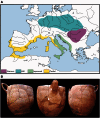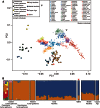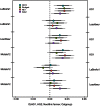A Common Genetic Origin for Early Farmers from Mediterranean Cardial and Central European LBK Cultures - PubMed (original) (raw)
. 2015 Dec;32(12):3132-42.
doi: 10.1093/molbev/msv181. Epub 2015 Sep 2.
Hannes Schroeder 2, Marcela Sandoval-Velasco 3, Lasse Vinner 3, Irene Lobón 1, Oscar Ramirez 1, Sergi Civit 4, Pablo García Borja 5, Domingo C Salazar-García 6, Sahra Talamo 7, Josep María Fullola 8, Francesc Xavier Oms 8, Mireia Pedro 8, Pablo Martínez 9, Montserrat Sanz 10, Joan Daura 11, João Zilhão 12, Tomàs Marquès-Bonet 13, M Thomas P Gilbert 3, Carles Lalueza-Fox 14
Affiliations
- PMID: 26337550
- PMCID: PMC4652622
- DOI: 10.1093/molbev/msv181
A Common Genetic Origin for Early Farmers from Mediterranean Cardial and Central European LBK Cultures
Iñigo Olalde et al. Mol Biol Evol. 2015 Dec.
Abstract
The spread of farming out of the Balkans and into the rest of Europe followed two distinct routes: An initial expansion represented by the Impressa and Cardial traditions, which followed the Northern Mediterranean coastline; and another expansion represented by the LBK (Linearbandkeramik) tradition, which followed the Danube River into Central Europe. Although genomic data now exist from samples representing the second migration, such data have yet to be successfully generated from the initial Mediterranean migration. To address this, we generated the complete genome of a 7,400-year-old Cardial individual (CB13) from Cova Bonica in Vallirana (Barcelona), as well as partial nuclear data from five others excavated from different sites in Spain and Portugal. CB13 clusters with all previously sequenced early European farmers and modern-day Sardinians. Furthermore, our analyses suggest that both Cardial and LBK peoples derived from a common ancient population located in or around the Balkan Peninsula. The Iberian Cardial genome also carries a discernible hunter-gatherer genetic signature that likely was not acquired by admixture with local Iberian foragers. Our results indicate that retrieving ancient genomes from similarly warm Mediterranean environments such as the Near East is technically feasible.
Keywords: Cardial ware; Neolithic; migration; paleogenomics.
© The Author 2015. Published by Oxford University Press on behalf of the Society for Molecular Biology and Evolution.
Figures
Fig. 1.
Early Neolithic Cardial culture. (A) Main cultural horizons associated with the earliest Neolithic of Central and Western Europe approximately 6,000–5,500 cal BCE. 1, Cova Bonica; 2, Cova de la Sarsa; 3, Cova de l‘Or; 4, Galeria da Cisterna-Almonda. (B) Cardial ceramics from Cova de la Sarsa. The impressed decoration is characteristically made with the serrated edge of cockle shells.
Fig. 2.
Genetic affinities of CB13. (A) Procrustes PCA of hunter–gatherers, Early Neolithic, Middle Neolithic, and Copper Age farmers. The PCA was performed using only transversions (to avoid confounding effects related to postmortem damage). (B) Ancestry proportions assuming 11 ancestral components, as inferred by ADMIXTURE analysis.
Fig. 3.
Outgroup f3-statistic analysis of CB13 Cardial genome. (A) Shared genetic drift between CB13 and present-day Western Eurasian populations. (B) Top 40 populations/individuals (modern and ancient) showing the highest genetic drift with CB13. Black and gray error bars represent two and three standard errors, respectively.
Fig. 4.
_D_-statistics to determine whether CB13 and other Neolithic farmers are closer to any hunter–gatherer. Black and gray error bars represent two and three standard errors, respectively.
Similar articles
- Ancient DNA analysis of 8000 B.C. near eastern farmers supports an early neolithic pioneer maritime colonization of Mainland Europe through Cyprus and the Aegean Islands.
Fernández E, Pérez-Pérez A, Gamba C, Prats E, Cuesta P, Anfruns J, Molist M, Arroyo-Pardo E, Turbón D. Fernández E, et al. PLoS Genet. 2014 Jun 5;10(6):e1004401. doi: 10.1371/journal.pgen.1004401. eCollection 2014 Jun. PLoS Genet. 2014. PMID: 24901650 Free PMC article. - Origins and genetic legacy of Neolithic farmers and hunter-gatherers in Europe.
Skoglund P, Malmström H, Raghavan M, Storå J, Hall P, Willerslev E, Gilbert MT, Götherström A, Jakobsson M. Skoglund P, et al. Science. 2012 Apr 27;336(6080):466-9. doi: 10.1126/science.1216304. Science. 2012. PMID: 22539720 - Tracing the genetic origin of Europe's first farmers reveals insights into their social organization.
Szécsényi-Nagy A, Brandt G, Haak W, Keerl V, Jakucs J, Möller-Rieker S, Köhler K, Mende BG, Oross K, Marton T, Osztás A, Kiss V, Fecher M, Pálfi G, Molnár E, Sebők K, Czene A, Paluch T, Šlaus M, Novak M, Pećina-Šlaus N, Ősz B, Voicsek V, Somogyi K, Tóth G, Kromer B, Bánffy E, Alt KW. Szécsényi-Nagy A, et al. Proc Biol Sci. 2015 Apr 22;282(1805):20150339. doi: 10.1098/rspb.2015.0339. Proc Biol Sci. 2015. PMID: 25808890 Free PMC article. - Iberia: population genetics, anthropology, and linguistics.
Arnaiz-Villena A, Martínez-Laso J, Alonso-García J. Arnaiz-Villena A, et al. Hum Biol. 1999 Oct;71(5):725-43. Hum Biol. 1999. PMID: 10510567 Review. - Last hunter-gatherers and first farmers of Europe.
Tresset A, Vigne JD. Tresset A, et al. C R Biol. 2011 Mar;334(3):182-9. doi: 10.1016/j.crvi.2010.12.010. C R Biol. 2011. PMID: 21377612 Review.
Cited by
- The genetic prehistory of the Baltic Sea region.
Mittnik A, Wang CC, Pfrengle S, Daubaras M, Zariņa G, Hallgren F, Allmäe R, Khartanovich V, Moiseyev V, Tõrv M, Furtwängler A, Andrades Valtueña A, Feldman M, Economou C, Oinonen M, Vasks A, Balanovska E, Reich D, Jankauskas R, Haak W, Schiffels S, Krause J. Mittnik A, et al. Nat Commun. 2018 Jan 30;9(1):442. doi: 10.1038/s41467-018-02825-9. Nat Commun. 2018. PMID: 29382937 Free PMC article. - Through 40,000 years of human presence in Southern Europe: the Italian case study.
Aneli S, Caldon M, Saupe T, Montinaro F, Pagani L. Aneli S, et al. Hum Genet. 2021 Oct;140(10):1417-1431. doi: 10.1007/s00439-021-02328-6. Epub 2021 Aug 19. Hum Genet. 2021. PMID: 34410492 Free PMC article. Review. - Evolutionary Patterns and Processes: Lessons from Ancient DNA.
Leonardi M, Librado P, Der Sarkissian C, Schubert M, Alfarhan AH, Alquraishi SA, Al-Rasheid KA, Gamba C, Willerslev E, Orlando L. Leonardi M, et al. Syst Biol. 2017 Jan 1;66(1):e1-e29. doi: 10.1093/sysbio/syw059. Syst Biol. 2017. PMID: 28173586 Free PMC article. Review. - Multi-scale ancient DNA analyses confirm the western origin of Michelsberg farmers and document probable practices of human sacrifice.
Beau A, Rivollat M, Réveillas H, Pemonge MH, Mendisco F, Thomas Y, Lefranc P, Deguilloux MF. Beau A, et al. PLoS One. 2017 Jul 5;12(7):e0179742. doi: 10.1371/journal.pone.0179742. eCollection 2017. PLoS One. 2017. PMID: 28678860 Free PMC article. - Ancient DNA and human history.
Slatkin M, Racimo F. Slatkin M, et al. Proc Natl Acad Sci U S A. 2016 Jun 7;113(23):6380-7. doi: 10.1073/pnas.1524306113. Epub 2016 Jun 6. Proc Natl Acad Sci U S A. 2016. PMID: 27274045 Free PMC article.
References
- Adler CJ, Haak W, Donlon D, Cooper A. 2011. Survival and recovery of DNA from ancient teeth and bones. J Archaeol Sci. 38:956–964.
- Allentoft ME, Sikora M, Sjögren K-G, Rasmussen S, Rasmussen M, Stenderup J, Damgaard PB, Schroeder H, Ahlström T, Vinner L, et al. 2015. Population genomics of Bronze Age Eurasia. Nature 522:167–172. - PubMed
- Andrews RM, Kubacka I, Chinnery PF, Lightowlers RN, Turnbull DM, Howell N. 1999. Reanalysis and revision of the Cambridge reference sequence for human mitochondrial DNA. Nat Genet. 23:147. - PubMed
Publication types
MeSH terms
Substances
LinkOut - more resources
Full Text Sources
Other Literature Sources



